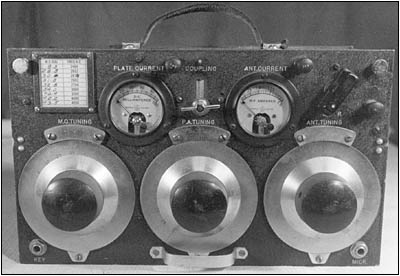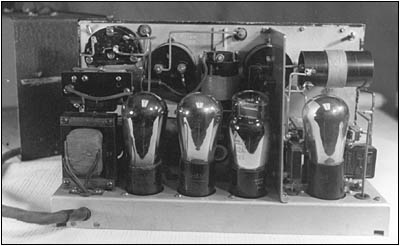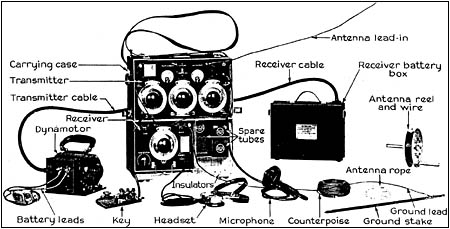Of Old Radios And Related Items--Published Monthly
A U.S. Coast Guard Transmitter
BY ALTON A. DUBOIS, JR.
WEB EDITION
In describing how he acquired more information about his U.S. Coast Guard transmitter, Alton DuBois shares a valuable lesson -- it pays to ask. (Editor)
Several years ago, I acquired from an antique shop a receiver and a transmitter that had no labels. Nevertheless, the knobs and the meters attracted my attention, and the price was reasonable. I had never seen a set like it before. When I got it home and opened it up, I found a U.S. Coast Guard label inside.
I placed an ad in the OTB and talked with Editor Ken Owens about it. He put some descriptions in his column and rcommended that I contact the Coast Guard Museum in New London, Connecticut. The staff there needed part numbers, so they had no information for me. They suggested the U.S. Signal Corps and the U.S. Army History Museum as possible sources -- still no information.
Sometime later, I got a phone call from Bill Holly of Kittery, Maine, who said that he had an identical transmitter that someone had butchered by removing coils and some parts. He sent me data with photographs that showed the units were made by General Electric in Schenectady, New York, in 1932 for the Coast Guard. General Electric built it as their Type RT-80A, and the Coast Guard designated it as a Model T-22 and CGR-22. The separate receiver and transmitter are part of a transportable radio station. It included a carrying case for the sets and the spare tubes, and a dynamotor to operate the transmitter from a 6-volt battery. The station came equipped with a typical antenna and ground appartus, as well as a battery box for the receiver.

Figure 1. The 5-watt Coast Guard Model T-22 (RT-80A) portable transmitter unit.
See what happens when you put the word out to the radio-collecting community?
Later on, I got more information from John Anderson at the General Electric Hall of History, located at the Cultural Museum in Schenectady. He has a large volume of material on General Electric and RCA.
A month later, I got a call from Ray Bintliff whom Bill had asked to restore his transmitter. Since I know Ray, I consented to his request that I send my transmitter to him as a model for rebuilding Bill's transmitter. It took several months of measurements and wire counting to restore Bill's botched up transmitter. However, I now have my receiver and transmitter back on my display shelf.
More about the Transmitter
When I got the equipment from the antique dealer, it contained the following tubes: a Type 112-A in the oscillator section, a Type 301-A in the final amplifier, and a pair of Type 201-As in the modulator.
This transmitter, shown in Figures 1 and 2, is simply a master oscillator and power amplifier (MOPA) arrangement that can be adjusted for various frequencies but has only five watts output. It is set up for operation using a key or microphone. The Type 301-A was burned out and dead. I don't think that the 301-A could stand the wattage, and therefore, it wasn't the correct tube type for the final. The pictures supplied by John Anderson indicate that all the tubes are Type 112-As.

Figure 2. The Model T-22 transmitter with its rear cover removed showing the Type 112-A 4-tube line-up.
I traced out the circuits and drew schematics for the receiver and transmitter. What a job! All the wires are solid conductor, rubber insulated with black cloth covering, and then bundled and laced. In tight areas, some parts had to be lifted out to get at contacts and tie-downs.
The Receiver
Like the transmitter, the receiver, shown in Figures 3 and 4 (see print version), is rather simple. It uses two Type 32 and one Type 30 tubes as an untuned RF stage, regenerative detector and audio output. As a 2-band receiver it covers 2.4 to 4.1 MHz. The complete T-22 system with all of its components is shown in Figure 5.
I hold an F.C.C. license, but I don't plan to fire up the transmitter, even with a dummy load.
It is interesting to compare this General Electric Model T-22 receiver/transmitter system with Western Electric's CW-936 system of 1917. (See A.R.C., September 2001). Both systems were made for the government and span 15 years progress in technology.
Photo credit: John Anderson
(Alton A. DuBois, Jr., 67 Peggy Ann Rd., Queensbury, NY 12804)
Alton DuBois has been interested in radio since working for an engineer after school in the 1930s for 10 cents an hour. Having worked in TV service for RCA since 1948, he is a founding member of the RCA Retirees Club. His collecting interests include antique clocks as well as radios.

Figure 5. The complete Coast Guard Model T-22 system, which includes the transmitter, receiver, generator, battery box and all components. (From GE documentation dated 7/14/32)
| [Free Sample] [Books, etc., For Sale] [Subscribe to A.R.C./Renew] [Classified Ads] [Auction Prices] [Event Calendar] [Links] [Home] [Issue Archives] [Book Reviews] [Subscription Information] [A.R.C. FAQ] URL = http://www.antiqueradio.com/Jan03_Dubois_CoastGuard.html Copyright © 1996-2002 by John V. Terrey - For personal use only. Last revised: December 10, 2002. For Customer Assistance please contact ARC@antiqueradio.com or call (866) 371-0512 Pages designed/maintained by Wayward Fluffy Publications
Antique Radio Classified |